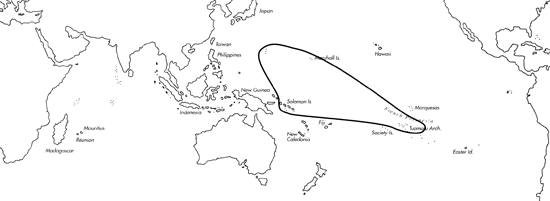
Skip Navigation Links
View access keys for this site.

Range: Central Pacific, from Guam to Wake Id. and Marshall Is. and to Cook Is. and Tuamotu Archipelago; probably also in Solomon Is.
Description: Moderately large, moderately light to moderately solid. Last whorl ovate, narrowly ovate, cylindrical or narrowly cylindrical; outline varies from moderately convex to almost straight and parallel-sided centrally; left side concave at basal third. Aperture wider at base than near shoulder. Shoulder angulate to subangulate, tuberculate. Spire low, outline straight to slightly convex. Postnuclear whorls tuberculate. Teleoconch sutural ramps flat, concave in later whorls; later ramps with 4 increasing to 10-12 fine spiral grooves. Last whorl with widely spaced weak spiral ribs at base and shoulder and with widely spaced, irregularly punctate shallow grooves centrally.
| Shell Morphometry | ||
|---|---|---|
| L | 57-65 mm | |
| RW | 0.09-0.17 g/mm | |
| RD | 0.47-0.52 | |
| PMD | 0.49-0.70 | |
| RSH | 0.10-0.12 | |
Ground colour white, suffused with pink and violet. Last whorl with a fine but usually incomplete network of light brown to dark reddish brown lines and often triangular spots; interrupted brown spiral lines and streaks may be present; reticulate pattern usually fusing in a discontinuous spiral band at centre and within basal third. Apex white. Later postnuclear sutural ramps with sparse brown radial lines and streaks on a pink ground; marginal tubercles usually white. Aperture white.
Habitat and Habits: Shallow water.
Discussion: C. eldredi is very closely related to C. geographus. The latter species attains much larger size and rarely has a pink ground colour; it differs in a lower spire (RSH 0.04-0.10) with a slightly concave outline, in stronger tubercles on the late sutural ramps, and in a smoother surface of the last whorl. The position of maximum diameter is generally closer to the shoulder in C. geographus (0.62-0.76) than in C. eldredi. Although further study of sympatric occurences is necessary, we consider that these differences justify separation at species level. For comparison with C. tulipa see the DISCUSSION of the latter species.

C. eldredi range map
This section contains verbatim reproductions of the accounts of 316 species of Conus from the Indo-Pacific region, from Manual of the Living Conidae, by Röckel, Korn and Kohn (1995). They are reproduced with the kind permission of the present publisher, Conchbooks.
All plates and figures referred to in the text are also in Röckel, Korn & Kohn, 1995. Manual of the Living Conidae Vol. 1: Indo-Pacific Region.
The range maps have been modified so that each species account has it own map, rather than one map that showed the ranges of several species in the original work. This was necessary because each species account is on a separate page on the website and not confined to the order of accounts in the book.
Return to framed version (returns to search page)